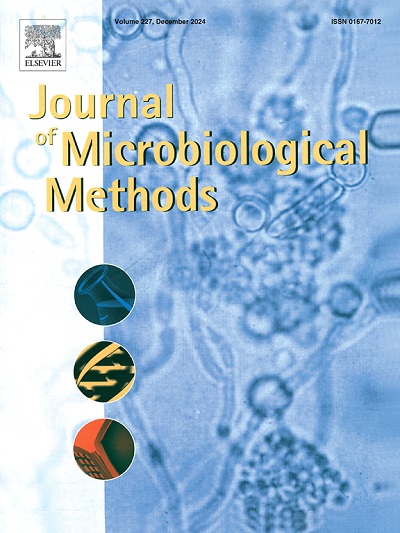Validation of pleural fluid group A Streptococcus and Staphylococcus aureus PCR assays and their potential clinical impact in children with complicated pneumonia
IF 1.9
4区 生物学
Q4 BIOCHEMICAL RESEARCH METHODS
引用次数: 0
Abstract
Background
Better diagnostic tools are needed to increase the yield and speed of pathogen identification in pediatric complicated community-acquired pneumonia (cCAP), and thereby, improve patient care through optimization of antibiotic therapy.
Methods
We performed analytical and clinical validations of a laboratory-developed group A Streptococcus (GAS) PCR and a commercially available Staphylococcus aureus (S. aureus), including methicillin-resistant S. aureus (MRSA), PCR for pleural fluid specimens and studied the potential clinical impact of pleural fluid GAS and S. aureus PCR testing in children with cCAP.
Results
Both assays demonstrated high analytical sensitivity, specificity, reproducibility, and accuracy in detection of their target pathogens in pleural fluid. In potential clinical impact analysis for 62 children with cCAP requiring pleural fluid drainage, the addition of GAS and S. aureus PCR testing to existing diagnostic testing increased pathogen yield from 71.0 % to 83.2 % (p = 0.023), decreased theoretical median time from hospitalization to optimal therapy from 5.1 days (95 % CI: 2.4–7.2) to 3.7 days (95 % CI: 1.9–6.9, p = 0.001) and theoretical median time from start to stop of unwarranted MRSA therapy from 1.5 days (95 % CI: 1.0–3.7) to 0.8 days (95 % CI: 0.5–1.2, p < 0.001).
Conclusion
PCR testing is a sensitive and specific method for detecting GAS and S. aureus in pleural fluid. Clinical implementation of these targeted pleural fluid PCR assays has the potential to significantly increase pathogen yield, facilitate faster de-escalation of MRSA therapy and transition to narrow, targeted antibiotics, suggesting their utility for pediatric complicated pneumonia.
患儿并发肺炎胸膜液A群链球菌和金黄色葡萄球菌PCR检测的验证及其潜在临床意义
背景:需要更好的诊断工具来提高儿科复杂社区获得性肺炎(cCAP)的病原体鉴定率和速度,从而通过优化抗生素治疗来改善患者护理。方法:对实验室开发的a群链球菌(GAS) PCR和市售的金黄色葡萄球菌(S. aureus),包括耐甲氧西林金黄色葡萄球菌(MRSA),对胸水标本进行PCR分析和临床验证,并研究胸水GAS和金黄色葡萄球菌PCR检测对cCAP患儿的潜在临床影响。结果:两种检测方法在检测胸腔液中的目标病原体时均表现出较高的分析灵敏度、特异性、重复性和准确性。在潜在的临床影响分析与工厂检查要求胸膜液体引流,62名儿童的气体和金黄色葡萄球菌PCR测试现有的诊断测试增加病原体收益率从71.0 % 83.2 % (p = 0.023),降低理论中值从5.1 天住院治疗的最佳治疗时间(95 %置信区间:2.4—-7.2)3.7 天(95 % CI: 1.9 - -6.9, p = 0.001)和毫无根据的理论中值时间从开始到停止从1.5 天治疗耐甲氧西林金黄色葡萄球菌(95 %置信区间:1.0 ~ 3.7) ~ 0.8 d(95 % CI: 0.5 ~ 1.2, p )结论:PCR检测胸膜液中GAS和金黄色葡萄球菌是一种灵敏、特异的检测方法。这些靶向胸膜液PCR检测的临床实施有可能显著提高病原体产量,促进MRSA治疗的更快降低,并过渡到狭窄的靶向抗生素,这表明它们对儿科并发症性肺炎的实用性。
本文章由计算机程序翻译,如有差异,请以英文原文为准。
求助全文
约1分钟内获得全文
求助全文
来源期刊

Journal of microbiological methods
生物-生化研究方法
CiteScore
4.30
自引率
4.50%
发文量
151
审稿时长
29 days
期刊介绍:
The Journal of Microbiological Methods publishes scholarly and original articles, notes and review articles. These articles must include novel and/or state-of-the-art methods, or significant improvements to existing methods. Novel and innovative applications of current methods that are validated and useful will also be published. JMM strives for scholarship, innovation and excellence. This demands scientific rigour, the best available methods and technologies, correctly replicated experiments/tests, the inclusion of proper controls, calibrations, and the correct statistical analysis. The presentation of the data must support the interpretation of the method/approach.
All aspects of microbiology are covered, except virology. These include agricultural microbiology, applied and environmental microbiology, bioassays, bioinformatics, biotechnology, biochemical microbiology, clinical microbiology, diagnostics, food monitoring and quality control microbiology, microbial genetics and genomics, geomicrobiology, microbiome methods regardless of habitat, high through-put sequencing methods and analysis, microbial pathogenesis and host responses, metabolomics, metagenomics, metaproteomics, microbial ecology and diversity, microbial physiology, microbial ultra-structure, microscopic and imaging methods, molecular microbiology, mycology, novel mathematical microbiology and modelling, parasitology, plant-microbe interactions, protein markers/profiles, proteomics, pyrosequencing, public health microbiology, radioisotopes applied to microbiology, robotics applied to microbiological methods,rumen microbiology, microbiological methods for space missions and extreme environments, sampling methods and samplers, soil and sediment microbiology, transcriptomics, veterinary microbiology, sero-diagnostics and typing/identification.
 求助内容:
求助内容: 应助结果提醒方式:
应助结果提醒方式:


